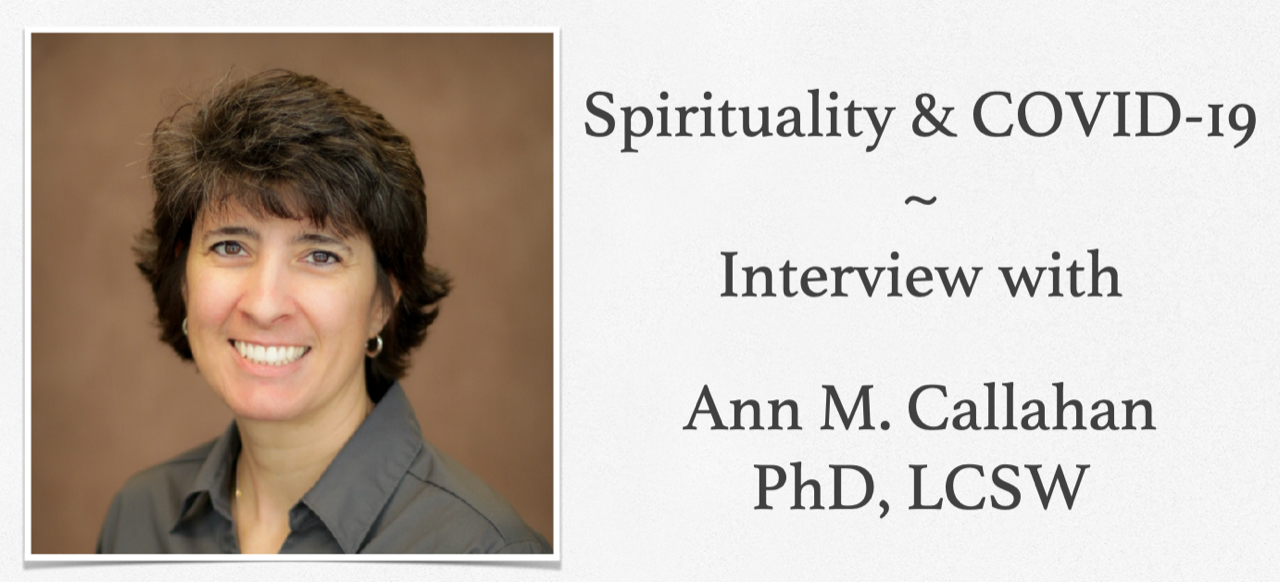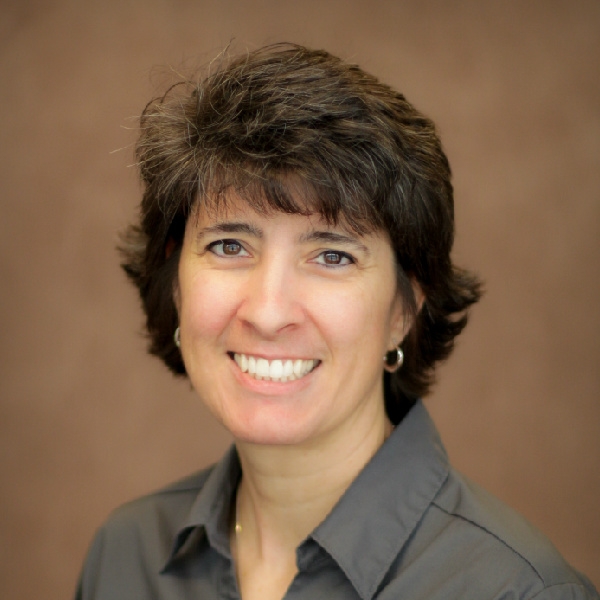
Faith and Hope Hospice in Pasadena is happy to welcome Dr. Ann M. Callahan, PhD, LCSW as a guest blogger. In this post, she discusses topics that came up in her COVID Conversation video.
~~~
It is natural for spiritual needs to emerge in response to life-limiting illness (Callahan, 2017; Reese, Nelson-Becker, & Callahan, under review), but the limits imposed by COVID-19 can leave patients and their families vulnerable to spiritual suffering. The following are the author’s responses to questions asked by a hospice and palliative care provider about the spiritual implications of COVID-19 for hospice providers, people at the end of life, their loved ones, and of those who are grieving a death. This COVID Conversation is a reminder of the importance of spiritually sensitive social work, including the need to ensure access to quality spiritual care.
What is spiritual wellbeing and how is COVID-19 impacting it? Simply stated, spiritual wellbeing is the product of meeting one’s spiritual needs. Like any challenging life event, COVID-19 can be an opportunity to experience spiritual well-being if one’s spiritual needs are met. If spiritual needs go unmet, this risks spiritual suffering. Relational spirituality is the experience of meaningful relationships, a type of connection that enhances life quality (Callahan, 2017). How and the extent to which relationships enhance life quality is relative to each person. Social workers can help patients meet their spiritual needs by helping them cultivate significant relationships. Sometimes these relationships are specific to the delivery of spiritual care.
How can religion/faith/spirituality be used to cope with or make sense of COVID-19 and the changes it’s having on our society? This is relative to what informs your definition of spirituality and/or your faith or religious tradition. Based on Callahan’s (2017) relational model, COVID-19 is a reminder of the significance of relationships and the need to facilitate relationships that support life quality. COVID-19 can help us be more intentional about how we cultivate healthy relationships with ourselves, others, and beyond (with a transcendent being or larger environment). For those who are religious, prayer or communal worship may cultivate meaningful relationships that inspire resilience. Traditional social work theories and skills can help patients and their families in this process, starting with an assessment to clarify how relationships inform life quality and ways to support them (Reese, Nelson-Becker, & Callahan, under review).
There are many religious traditions that occur before and after a death. How are these being impacted by COVID-19 and what workarounds have you seen? Religious leaders have relied on technology much like health care professionals have relied on telemedicine for service delivery. Rituals that occur before and after death can be delivered virtually with coordination. This necessitates access to broadband internet, a computer, and/or phone as well as technology skills to facilitate virtual presence. Additional accommodations are needed for a conference call and/or if patients have special needs, i.e., cognitive or hearing impairments, non- or minimally responsive.
Social workers can help patients and their families access spiritual care by facilitating this “safe” connection in a number of ways:
- Evaluate accessibility: Assess comfort (fear of Zoom bombing or computer virus with Zoom download), technology (type of technology, age of technology), broadband connectivity (internet speed, connection stability), and skills (logging into Zoom, Skype, etc.)
- Prepare the environment: Provide adequate lighting to highlight facial features, position screen for face/eye contact, meet in a quiet space, wear solid colors to avoid distraction, and monitor environment for privacy
- Facilitate a quality transmission: Ensure computer settings support continuous quality transmission of live or pre-recorded audio/video. For live transmissions, audio alone is most stable. An auxiliary speaker may allow better sound quality and volume range.
There are a number of online toolkits that support professional preparedness for other types of interventions with list of resources following the references.
How can we, as healthcare professionals or the average person, support patients and families facing life-limiting illness and grief? Support opportunities to grieve and seek closure rather than leave loss ends of ambiguous loss. As described by Doka (1989), grief that is socially sanctioned and publicly mourned facilitates healing. Ambiguous loss risks prolonged grief. Most traditional means of coping transcend the limits of COVID-19. This includes crying, talking with others, creating a memory book/container, creating a playlist of songs, journaling, planting a tree/plant/flowers, creating commemorative art, visiting a loved one’s final resting place, and reading books that inspire spiritual healing.
Other opportunities to grieve and seek closure over time can be modified with reliance on technology, Personal Protective Equipment (PPE), social distancing, and good hygiene/cleaning practices. With PPE, a loved one may sit with a patient one at a time. Photographs, memorabilia, and other items may be placed around a patient to symbolize a loved one’s presence. Healing prayers and last rights may be delivered remotely. A memorial service may take place in a small group that is livestreamed, recorded, or documented to include those not present. Loved ones could have a candle-lighting ceremony that consists of special readings, music, and sharing of memories.
These extraordinary times have led to extraordinary access to bereavement support across geographic bounds and systems of belief. For example, GriefShare provides a Christian bereavement support group curriculum with videos and workbook produced by an organization called the Church Initiative (2020). GriefShare had traditionally been delivered onsite at Christian churches by volunteers across the country, but some GriefShare groups have moved online. GriefSharealso has an email listserv for daily inspiring messages. There are many other resources online with some accessible through social media platforms for synchronous and asynchronous connections.
Leaning on a strengths perspective, what good might come from COVID-19 related to faith/spiritual wellbeing? It is hard to predict how COVID-19 will impact an individual’s long-term faith/spiritual wellbeing. Some of this depends on our “new normal”. Virtual resources have allowed access to spiritual care that might not otherwise be available. There is also increased awareness of health care providers as essential workers and a commitment across professions to support self-care. Taken together, it seems COVID-19 has highlighted the importance of relationships as people have fought to find ways to cultivate relationships that sustain them, even in the face of death.
~

Ann M. Callahan, PhD, LCSW is an Associate Professor and Master of Social Work Program Director and Online Coordinator at Eastern Kentucky University. She earned her doctorate in social work from the University of Tennessee, Knoxville. Dr. Callahan is licensed in clinical social work with over 20 years collective experience as a social work educator, practitioner, and researcher. Dr. Callahan’s research focuses on spiritually sensitive social work in hospice, palliative, and long-term care. This includes the book Spirituality and Hospice Social Work, published by Columbia Press, which delineates the foundation for her research.
References
Callahan, A. M. (2017). Spirituality and hospice social work. New York: Columbia University Press.
Church Initiative. (2020). Creating life-changing support groups in your church. https://www.churchinitiative.org/?_ga=2.232420439.979921721.1592839509-1847480318.1592572378
Doka, K. J. (1989). Disenfranchised grief: Recognizing hidden sorrow. Lexington, MA: Lexington Books.
Reese, D., Nelson-Becker, H. & Callahan, A. M. (under review). Spirituality and social work practice in palliative care. In T. Altilio, S. Otis-Green, J. Cagle, & R. Brandon (Eds.), Oxford textbook of palliative social work (2nd ed., pp. TBA). New York: Oxford University Press.
Resources
Centers for Disease and Control Prevention (CDC). (2020, May 23). Interim guidance for communities of faith. Retrieved on June 22, 2020, from https://www.cdc.gov/coronavirus/2019- ncov/community/organizations/guidance-community-faith-organizations.html
Social Work Hospice & Palliative Care Network. (2019). Resources for hospice & palliative care social work professionals during the COVID-19 crisis. Retrieved on June 22, 2020, from https://www.swhpn.org/COVID19
Spiritual Care Association. (2020). Coronavirus pandemic resources from SCA. Retrieved on June 22, 2020, from https://www.spiritualcareassociation.org/coronavirus.html
Spiritual Care Association. (2020, March 24). Strategies for spiritual caregivers dealing with the chaos of coronavirus and other infectious disease threats.https://spiritualcareassociation.org/docs/resources/coronavirus_resource_list.pdf Note: This includes a hyperlink list for denominational statements on COVID-19.
HealthCare Chaplaincy Network. (2014). Patient’s spiritual and cultural values for healthcare professionals.https://www.spiritualcareassociation.org/docs/resources/patients_spiritual_and_cultural_values_for_health_care_professionals.pdf
Hospice Foundation of American. (2018). Providing spiritual and pastoral care during COVID-19.https://hospicefoundation.org/Education/Free-COVID-19-Programs.aspx Note: This is an on-demand webinar with 1.5 complimentary continuing education credits available until 04/21/21.
~~~
Faith & Hope Hospice is dedicated to providing the best hospice care Los Angeles has to offer and bringing helpful information to our clients and community. This is especially true during the time of COVID. That’s why we are presenting COVID Conversations: a new web series on coping through the pandemic with interviews conversations and information. Find more at www.faithandhopehospice.com/COVID
Click here to learn more about hospice and how Faith & Hope Hospice in Los Angeles improves quality of life for our patients and their families.
